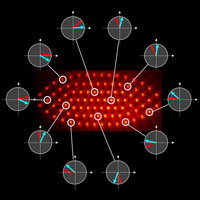Abstract
Ramsey interferometry is a widely used tool for precisely measuring transition frequencies between two energy levels of a quantum system, with applications in time keeping, precision spectroscopy, quantum optics, and quantum information. Often, the coherence time of the quantum system surpasses the one of the oscillator probing the system, thereby limiting the interrogation time and associated spectral resolution. Correlation spectroscopy overcomes this limitation by probing two quantum systems with the same noisy oscillator for a measurement of their transition frequency difference; this technique has enabled very precise comparisons of atomic clocks. Here, we extend correlation spectroscopy to the case of multiple quantum systems undergoing strong correlated dephasing. We model Ramsey correlation spectroscopy with particles as a multiparameter phase estimation problem and demonstrate that multiparticle correlations can assist in reducing the measurement uncertainties even in the absence of entanglement. We derive precision limits and optimal sensing techniques for this problem and compare the performance of probe states and measurement with and without entanglement. Using one- and two-dimensional ion Coulomb crystals with up to 91 qubits, we experimentally demonstrate the advantage of measuring multiparticle correlations for reducing phase uncertainties and apply correlation spectroscopy to measure ion-ion distances, transition frequency shifts, laser-ion detunings, and path-length fluctuations. Our method can be straightforwardly implemented in experimental setups with globally coherent qubit control and qubit-resolved single-shot readout and is, thus, applicable to other physical systems such as neutral atoms in tweezer arrays.
6 More- Received 18 February 2023
- Revised 19 December 2023
- Accepted 8 February 2024
DOI:https://doi.org/10.1103/PhysRevX.14.011033
Published by the American Physical Society under the terms of the Creative Commons Attribution 4.0 International license. Further distribution of this work must maintain attribution to the author(s) and the published article’s title, journal citation, and DOI.
Published by the American Physical Society
Physics Subject Headings (PhySH)
Popular Summary
In quantum sensing, quantum systems are used as probes with superior measurement precision compared to classical sensors. A key task in this context is phase estimation, as determining the phase of a quantum system’s superposition state provides relevant information about the environment. Here, decoherence, the loss of well-defined phase relationships from noise processes affecting a quantum sensor, poses a significant challenge. By harnessing correlation spectroscopy, where multiple qubits exposed to the same noise are probed simultaneously, we extend the possible probe time beyond single-particle coherence.
Correlation spectroscopy has been demonstrated before, enabling the precise comparison of atomic clocks. In our work, we extend correlation spectroscopy to many qubits in experiments with linear and planar ion Coulomb crystals consisting of up to 91 ions. We show that correlation spectroscopy is a versatile tool for determining spatial transition frequency shifts and tracking phase fluctuations in time. We also uncover novel features of correlation spectroscopy by analyzing -particle correlations instead of correlating only measurement results on pairs of qubits. Analysis of -particle correlations leads to a reduction of phase uncertainty and, for our estimation task, entanglement can provide only a small advantage that vanishes in the limit of many qubits.
Our techniques are also applicable to other experimental platforms capable of measuring qubits individually, such as atoms held in optical lattices or tweezer arrays.



